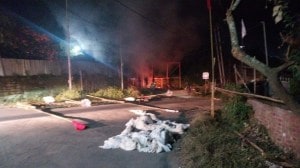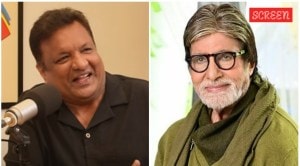Stay updated with the latest - Click here to follow us on Instagram
The heat signature
Long used by the military for surveillance, thermal imaging now finds other uses — at airports and hospitals and, like in the Charlie Hebdo case, to hunt down suspected killers.
 A thermal camera monitors body temperatures for signs of infections at an airport, to counter Ebola spread. (Source: AP)
A thermal camera monitors body temperatures for signs of infections at an airport, to counter Ebola spread. (Source: AP)
By John Markoff
The thermal imaging systems used by the French police to find the two brothers suspected in the Charlie Hebdo massacre last week are based on a rapidly evolving technology now turning up in hospitals, airports and even smartphones.
Like GPS, thermal imaging was once used exclusively by military and law enforcement. In the early 1990s, National Guard aircraft relied on thermal sensors to look for illegal drug activity at the Branch Davidian Compound in Waco, Texas.
In 2013, a Massachusetts State Police helicopter used thermal imaging to locate Boston bombing suspect Dzhokhar Tsarnaev, after a homeowner reported that the bloodied fugitive was hiding in a boat in his yard.
Last June, a military surveillance aircraft equipped with infrared sensors played a key role in the hunt for Justin Bourque, a fugitive who had killed three police officers in Moncton, New Brunswick. The cameras found him hiding in deep brush late at night.
While humans see reflected light, all objects that surround us — other people, animals and even “cold” objects such as ice — give off heat, radiation beyond the visible spectrum that can be imaged in the form of a “heat signature.” A human body usually gives off more heat than the surrounding field, so it stands out.
Unlike night-vision devices, which amplify small amounts of visible light, thermal imaging cameras rely on sensors known as microelectromechanical systems, or MEMS, to make images from heat. Thermal imaging cameras are made up of a large array of exotic MEMS devices, as well as specialised optics. Conventional glass and plastic lenses cannot be used because they block heat. Instead, these cameras require special lenses manufactured of transparent silicon.
Long used by the military for surveillance, thermal imaging has raised privacy concerns. In 2001, the Supreme Court ruled that the use of sensors by police to detect marijuana plants growing inside a home violated civil liberties because it constituted an unreasonable search.
Justice Antonin Scalia wrote in the Kyllo vs United States case that the thermal imaging sensors could reveal things that the average person standing outside a home would not be able to determine — for example, whether “the lady of the house” might be taking “her daily sauna and bath.”
Yet despite Fourth Amendment restrictions, the technology has rapidly found its way into low-cost commercial applications where there are no clear legal barriers.
Essess, a software company started by researchers from the Massachusetts Institute of Technology, has equipped a fleet of vehicles with thermal imaging sensor arrays that make it possible to quickly map energy efficiency in neighbourhoods of household and commercial buildings.
At FLIR Systems of Wilsonville, Oregon, the world’s largest maker of thermal imaging gear, military and government customers once accounted for 70 per cent of sales; today that figure is roughly 30 per cent. The company, which had $1.5 billion in revenue in 2013, now makes thermal imaging cameras for consumers that cost less than $300.
“Our target is the do-it-yourself homeowner,” said Andy Teich, FLIR’s chief executive. The company also sells a thermal imaging system that connects to smartphones and allows homeowners to hunt for cold air leaks and plumbing problems.
Teich said he kept an obsolete military GPS system in his office to remind him of the parallels between that technology and thermal imaging. Once used just in military missiles and planes, GPS receivers are now standard in many consumer devices.
Thermal imaging technologies have also become part of the arsenal used to halt the spread of disease. Infrared cameras at airports detect high body temperature as passengers pass through airport terminal checkpoints.
The cameras, which can detect changes in body temperature as small as one-tenth of a degree Fahrenheit, were initially used in Southeast Asia in response to outbreaks of SARS and bird flu, and more recently to alert officials to individuals who might have contracted Ebola.
Photos




- 01
- 02
- 03
- 04
- 05



























